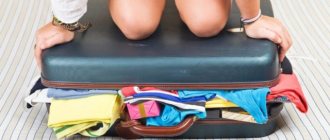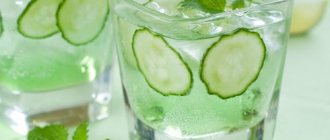Food for the road: selection rules
Regardless of whether you travel by train or by car, the same rules apply when it comes to choosing food for the road:
- we exclude perishable foods from the list of travel provisions, otherwise your vacation will begin with diarrhea, and every day counts for you;
- We choose products that do not thaw. If you want ice cream, it is better to buy it during one of the stops;
- We select food that does not crumble and does not stain your hands. The less worries you have on the road, the more comfortable the trip;
- We take food on the train that does not have a strong odor. Garlic, onions and even boiled eggs create an indescribable amber that your compartment neighbors will have to smell. Have compassion for them;
- we make our life easier: we select products that do not require cleaning, then there will be no problems with taking out the garbage either;
- There is no place to cook in the car or train, so we take ready-made food on the road or for the preparation of which you just need to add boiling water;
- dealing with sliced food on the road is also not easy, so we do it at home and put already sliced bread, sausage, etc. in the travel bag.
Personal equipment and clothing
On any hike, you need to think through your activities in advance, i.e. clearly understand your actions on site, the weather, food, so that later you can do the right thing when getting ready.
Backpack
A backpack is the main attribute of a hiker, but if you are traveling by car and are going to camp nearby, then you won’t need a large backpack, especially since you don’t take a lot of clothes. A backpack of up to 50 liters is enough. Typically, clean things, valuables, and photographic equipment are stored in a backpack, and the backpack is taken with you to the tent. During the day he is needed to take the necessary things and food for forays out of the camp.
The range of prices for backpacks for hiking is very wide, it depends on the brand and the manufacturability of the materials, here I offer the most acceptable budget options.
Shorts
Swimming shorts are a must have for the sea or forest in the heat. This is a universal thing; personally, I wear short swimming shorts both in the mountains and in the sea. Firstly, it’s not hot, secondly, you can always swim (along the way in a river or in the sea), thirdly, they dry quickly, fourthly, they are easy to wash, and fifthly, they are inexpensive. And on bare legs it is much easier to see, for example, a tick; usually it does not bite on the legs, preferring softer places higher up.
Slippers
As personal experience shows, they are always needed ( in autumn, summer and winter). For example, if you got your main shoes wet, what should you wear while they dry - slippers. If it’s too hot outside for a regular walk, and you’re afraid to go barefoot, again, use slippers. What to wear to sail on a boat without fear of getting your feet wet – slippers, of course (but diving boots or coral slippers are better).
Slippers should preferably be their own size so that they do not fall off in an extreme situation. The choice of slippers is large, you can get Chinese ones for 200 rubles, or you can get an advanced version like CROCS.
Crocs are of course more comfortable, durable and do not slip on smooth surfaces, and also stay on the foot better. I've already walked a lot in my Crocs, and they performed great.
Trousers
Basic requirements for summer pants: thin, light, quick-drying. The main purpose of pants in summer is to protect against insects and vegetation (thorns, sharp branches, etc.). Advanced models may be waterproof (with a membrane), but most likely they will be much more expensive and warmer, and in the summer we don’t need this, so the main thing is that they are thin and dry quickly, therefore synthetic.
Windbreaker
It is advisable that the windbreaker be waterproof. A windbreaker is usually needed in the rain or during cool winds. I recommend taking the thinnest windbreaker that can fit in your pocket. It will not take up space and can be taken on every hike, and if you wear a fleece jacket under it, you will be very comfortable even in the cold. Such windbreakers are made, for example, by ODLO, Colubia, Salomon, and The North Face.
Panties, socks
In summer we sweat intensely and lose freshness quickly. You need to take 2-3 pieces. For example, after the first hot day you will already want to wash yourself and sleep in clean linen, it’s so nice.
T-shirts
In summer, it is better to have one long-sleeved gauze with you (so as not to burn in the sun) and 2-3 pieces of regular short-sleeved T-shirts. Select one as a nightie and sleep in it, one (decent looking) for the road and going to stores, and one for travel, which can be easily washed and dried at night.
I often wear a thin synthetic T-shirt with a cooling effect, it copes well with the heat and dries quickly. Usually on the road I rinse it out of sweat in the river several times and immediately put it on wet, it dries quickly on the body.
Sweatshirt or jacket
Naturally, the sweatshirt is not too warm, since in the summer it will be needed mainly in the evening, when mosquitoes and midges fly in. I chose a cotton robe with a hood, firstly it is not hot in it, secondly it protects against mosquitoes, and I also stuff it with other things and make a pillow to sleep comfortably at night.
Sneakers
Sneakers are the main footwear of a summer tourist. I recommend not saving on shoes; it’s better to take sneakers that will last you 8 years, with a tenacious tread, good rubber and a breathable waterproof membrane. These can cost up to 10,000 rubles, but they are worth it. I’ll say right away that all sorts of Reebok, Adidas, Nike do not make such shoes. Among the affordable and good ones you can take Salomon, Columbia, Merrell, Salewa. Make sure that GTX is in the name - this means there is a stocking made of GORE-TEX membrane (the shoes breathe and do not get wet).
It is advisable to take shoes with high soles so as not to drown in every shallow puddle. The foot should be well fixed so that, for example, when descending from a mountain, your toes do not rest on the toe of the shoe (this is very painful during a long descent).
DO NOT TAKE: Outventure, Demix (which are usually sold in Sportmaster) - this Russian-Chinese “G” only looks beautiful (I mean shoes, you can take some of the equipment).
Hobba is an accessory that I take everywhere and always. This is an individual seat that rests on your belt and is comfortable to sit on at any time. Usually it is always at the waist and it is comfortable to sit on a stone, on the sand or on a log. In general, take it, you won’t regret it, it’s quite inexpensive, from 250 rubles.
We've more or less sorted out the clothes, now let's talk about camp equipment, i.e. about cooking and spending the night in a camp.
What food to take on the train - list
When packing your suitcases at sea, take with you foods whose presence in your travel diet will not lead to poisoning and will not cause additional hassle associated with cleaning, preparation and disposal.
We recommend taking with you foods that do not require cooking:
- vegetables already washed at home: cucumbers, carrots, sweet peppers. It’s better not to take risks with tomatoes, since there is a high probability of staining your clothes;
- fruits: apples, pears, plums, apricots. They will weigh down your luggage, so you can take fruit purees on the train as an alternative;
- sandwiches with cheese, meat, sausage. Do not spread butter on bread: it melts and loses its taste. Choose smoked sausages and use well-done meat - these products are stored for a long time at normal temperatures;
- pate in small packages. Tasty, satisfying and convenient: I ate the contents and threw away the jar;
- processed cheese in plates and portioned triangles. It will not deteriorate during the trip, and getting rid of the packaging will not be difficult;
- canned fish, just choose cans that can be opened without a can opener;
- pre-sliced bread or pita bread. On the go, you can combine it with sausage, cheese, vegetables and other goodies;
- yogurt, just buy one with a specified maximum storage temperature of 25°C;
- nuts and dried fruits for snacks. Unlike sweets, they will not melt and will not stain your hands;
- marshmallows and marshmallows for dessert - these sweets tolerate the heat well;
- water, drinks. It is better to avoid sodas: they do not quench thirst, but increase it;
- salt, if you need to salt something on the road.
Semi-finished products requiring minimal cooking:
- porridge, noodles and instant mashed potatoes in plastic cups. There will always be boiling water on the road, and within 5 minutes a hearty lunch will be ready;
- tea and coffee in bags, and don’t forget to grab sugar, also packaged in portions.
Home-cooked food:
- baked meat. When preparing it, it is advisable to use more spices: rosemary, oregano, tarragon, which are natural preservatives. Medium and medium-rare meat spoils quickly, so exclude it from the list of road food;
- Butter pies and muffins are perfect for an afternoon snack.
And don’t forget the golden rule of “KLMN”: mug, spoon, bowl, knife. The dishes must be unbreakable, that is, either metal or plastic. An excellent solution is disposable plates: they take up little space, weigh little, and don’t require washing.
WEIGHT MATTERS
The first rule of a traveler is that food should be nutritious, but light in weight. That’s why we give preference to lightweight packaging.
“If you go for several hours, a snack is enough for you,” says tourism instructor Stepan Pogoreltsev. – We take dried fruits with us, they are light and do not take up much space. Nuts and nutrition bars. Tea or coffee in a thermos, and that’s it – you’re ready.
Another question if the trip takes a couple of days and you are going to cook. Firstly, you can’t do without a primus stove. Hot meals are the basis of good health. And at the fire you will be tortured to cook soup or porridge.
Secondly, you definitely need to take cereal. Rice and buckwheat are suitable for both porridge and soup. Pasta can be eaten alone or with broth. We select the quantity based on the size of the company. On average, one person needs about 600 g per day.
Another indispensable product on a hike is stew. So that you don’t have to cook porridge from an axe.
– Take the stew in vacuum packaging: it takes up less space and is lighter. You can make soup from the stew. If you add it to porridge, you get a complete dinner,” Pogoreltsev clarifies.
What not to take on the road
Having described the food that you should take with you, we will also list the foods that you should avoid on the road:
- from chocolates and chocolate - they melt in the heat;
- from boiled eggs - because of the smell;
- jacket potatoes get your hands dirty;
- from sausages, boiled sausage, chicken - they quickly become unusable;
- from pickled cucumbers and tomatoes, dried and salted fish - cause thirst;
- alcohol - not everyone likes the smell of fumes and rowdy neighbors.
Where we are going?
- Girls!
Come on a hike with us! – What kind of girls we are to you! We've already been on the hike twice! © folk tourism art. To begin with, let’s decide that we ourselves will not be going on a serious hike based on this article, and we do not advise you to do so. And in general, without experience of small weekend trips, you shouldn’t rush into the abyss of tourist life. So we'll look at two options. Departure for one day and departure with an overnight stay.
In the first case, you go on vacation by train, bus or even car in the morning, and return in the evening - happy and satisfied. In the second case, you also spend the night in nature. Depending on which option you choose, the contents of your backpack will change.
What to take with you when going to the beach
The beach is sun, sand and... insects. Therefore, the food you decide to take with you to sea should:
- withstand heat - the list is given below;
- be well packaged - use plastic bags and containers;
- have little weight.
Such products include:
- homemade cupcakes. However, not everyone will want to bake while on vacation, so you can buy low-fat crackers at the store;
- vegetables: cucumbers, tomatoes, radishes, kohlrabi;
- fruits. The same ones that we recommended to take on the train will do, but put the plums and apricots in hard packaging;
- nuts and dried fruits. Pre-divide them into portions and pack them, thereby preventing sand from getting into them;
- water, homemade lemonade. But do not drink very cold drinks, otherwise instead of swimming in the sea you will have to be treated for a cold;
- sandwiches. Make them the same way you would make sandwiches for travel.
Have a nice rest!
List of things for a picnic
When going on a picnic, you need to take care not only of food, but also of other useful things that will make your vacation comfortable and interesting (Figure 4).
It’s better to make a list of what you need in advance. When going outdoors at the last minute, you risk forgetting something important.
To ensure that your outdoor recreation leaves only pleasant impressions, you should take with you:
- Essential items:
these include a blanket or rugs for sitting, a tablecloth that will replace the table, plastic or paper dishes, napkins, a grill, coals and matches for the ignition. You can also take a tent or umbrella with you for protection from the sun. - Packaging:
it is convenient to take ready-made meals with you outdoors in containers. But the main thing in outdoor recreation is cleanliness. Leaving trash behind is bad manners, so trash bags must be included in your picnic packing list. - Items for entertainment:
if children will be present at the picnic, you need to think through leisure options for them in advance. You should take a ball, frisbee and badminton with you. If the picnic is on the shore of a reservoir, be sure to take swimming circles and armbands with you. For the little ones, it's worth bringing sand sets or an inflatable pool.
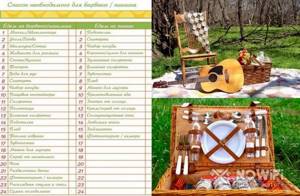
If any of the adults knows how to play the guitar, you should definitely take this musical instrument with you. Cards or board games are also worth bringing as entertainment for adults. And, of course, you need to take a camera or video camera with you to capture memorable moments.
https://youtu.be/nTq14BCrJSg
Act five, optimistic
It's too early to despair. In the end, you are not alone, you still have the strength to whine and curse at the owner of the dacha, who did not bother to learn an alternative route to the final transport stop. In this situation, you are solely a victim of circumstances. Get used to this thought, and for a fleeting moment you will feel better.
When you finish reflecting, it’s time to start looking for ways out of the current situation. At the same time, the most obvious does not mean the only true one. Remember that stupidly going to the light is not recommended. Firstly, in the dark distances are perceived incorrectly, and your hundred meters is a good five kilometers through potholes and grass as tall as Shaquille O'Neal. Secondly, it may happen that on the way to the desired source of light you will have to encounter guard dogs who consider you suspicious and edible at the same time. Thirdly, the light may be lonely and deserted, and you have already sobered up enough to have a conversation with a roadside lamp.
Comfortable and durable shoes will prevent many problems on vacation Photo: pixabay.com
Act one, preparatory
When looking around the wine and vodka racks, remember that two bottles of vodka are significantly less taxing on your hands than eight liters of beer.
And also the fact that the object of vodka’s close attention is your brain, while beer can cause your frequent absences from the upcoming social event. However, all this advice is of no use if you suddenly, without asking the opinions of others, decide to experiment and take a couple of liters of that red draft wine of unknown consistency. By breaking the first rule, you laid the foundation for future troubles, although at that moment it seemed to you that the day was going well. Your choice of alcoholic drinks or refusal of them will determine your impressions of the future picnic. Source
Always with you
First, we collect the unchangeable part, without which you never leave home. After the first trip to nature, you can check the completeness and put the “blank” on the mezzanine. Next time this will help speed up the collection process.
Mug, spoon, bowl, knife. To remember, we use the mnemonic rule - ёКЛМН. Without these four things there is nothing to do in the forest. It will be sad, hungry and generally bad. There is no need to use Sevres family porcelain for the trip. Ideally, the mug and bowl should be made of plastic, simple and convenient.
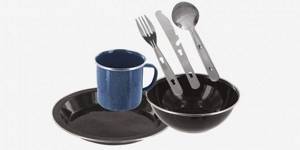
Yuri Muller
Plastic is a difficult issue. Plastic dishes do not rattle and do not heat up, but it is more difficult to wash them, and, as you understand, it is impossible to heat anything in them. For example, I prefer a regular lightweight stamped stainless steel mug in a removable leather case.
A mug with a handle is better than a glass. Why? Often you have to scoop up boiling water with a mug, and if you have a glass, then this turns into an exciting but dangerous sport. If the mug is metal, old, enameled, then as an upgrade, insert a wine cork into the handle. This way you can hold it normally, even when boiling water is poured inside.
On the same topic

Get the knives. The best blades for the city according to the authors of WARHEAD.SU
You don't need a table knife. Or rather, there is no need for a canteen in the forest at all. It is advisable to find a simple and convenient folding one that can be used to cut sausage and cut rope, if necessary.
Separately pack your cosmetic bag (if you are a brutal man, call it a toiletry bag). Pack some toothpaste and a brush, even if you're not planning a sleepover, as well as a small bar of soap. Little weight - many benefits. Place salt in a Kinder Surprise egg or a bottle of vitamins. The chances that it will be forgotten in the general layout, alas, are very high.
Take care of your personal medications - only you know which pills you should not leave home without. Send ten meters of toilet paper and lens solution there. A pack of wet and dry wipes completes the list.
Yuri Muller
I'll add. Be sure to have a lighter, preferably a pair. Kindling means are not for everyone.
Water - liter.
Phone - FULLY charged, plus power bank. Send SMS and all that if you get lost.
At least the minimum requirement (specifically for yourself, in addition to the general nutrition plan) for food - chocolate bars, a can of canned food.
And you really need repellents for mosquitoes and ticks.
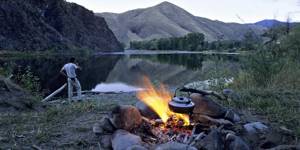
(Photo source)
Nuances regarding drinks and documents
Remember: before going on a trip to nature, first of all think about drinking water, and only then about alcoholic beverages. Practice shows that most often tourists do not have enough ordinary water. Take it at a rate of at least 3 liters per person. Don't forget that you will use water not only for drinking, but also for washing your hands, cutlery and food.
If you have children traveling with you, take them several packs of natural juice or high-quality lemonade.
An important nuance regarding alcoholic beverages. If possible, try to choose those that come in plastic rather than glass containers. Plastic weighs less, is more durable and safe.
But it’s better not to take any documents with you. There is a possibility that they will be lost or damaged during a picnic. The only exception is if you are traveling out of town by car. In this case, the driver, of course, needs to have a full set of documents with him.
Documents for other vacationers may be required only in one case - if they went outdoors while staying abroad. The instructions before traveling abroad require them to have their passports with them.
How to entertain children?
Many schools have preserved the good old tradition of going on hikes in the summer. They can be tedious for adults, but children really like them. If you're wondering what to bring on a class trip, first decide what sports games you'll be playing. Children quickly get bored of simply sitting in a tent or by the fire, so it’s better to immediately get them involved in sports activities. To do this, take with you:
- soccer or volleyball ball. If you plan to play volleyball, don't forget the net. It can be stretched between two tall poles stuck into the ground;
- kite;
- badminton rackets and shuttlecocks;
- several jump ropes.
If you are traveling out of town with junior classes, you can take simpler entertainment, for example:
- coloring books with pencils or felt-tip pens;
- bubble;
- children's books.
My class and I are going to nature: what medicines should we take?
During active play, children can get scratches or abrasions, so first of all you will need a bandage, plasters, brilliant green and iodine. In addition, the first aid kit must include:
- stomach upset medications;
- several packs of activated carbon;
- children's antipyretic;
- aspirin;
- a scratch disinfectant, such as hydrogen peroxide;
- repellent - a protective agent against blood-sucking insects;
- cream or balm that relieves itching after their bite.
The repellent is especially useful where there is a body of water nearby. Don’t forget it if you are deciding what to take with you on a trip to the sea. In summer, in many coastal countries, mosquitoes greatly annoy vacationers.
